In 1997, Ole Seehausen, Jacques van Alphen and Frans Witte published a paper in Science providing evidence for a novel route through which eutrophication can reduce species diversity. Species of cichlid fish in Lake Victoria are capable of interbreeding, but mate choice based on coloration and subsequent assortative mating keeps species distinct. Seehausen and colleagues found that water turbidity constrains colour-based mate choice and subsequently breaks down pre-mating reproductive barriers between species. Nineteen years after the paper was published, I asked Ole Seehausen about the making of this study, memories of field work, and what we have learnt since then about mate choice in cichlids and the impact of eutrophication on species diversity and evolution.
Citation: Seehausen, O., Van Alphen, J. J., & Witte, F. (1997). Cichlid fish diversity threatened by eutrophication that curbs sexual selection. Science, 277(5333), 1808-1811.
Date of interview: Questions sent by email on 22nd August 2016; responses received by email on 16th December 2016
Hari Sridhar: Your first publication on cichlid fishes is a book you published in 1996. The next year you published this paper in Science. Can you share with us how and at what stage in your career did you first get interested in the cichlid fishes of Lake Victoria?
Ole Seehausen: I loved fish as a child and became an aquarist at the age of 10. As a youth I bred various fish in my home tanks. Cichlid fishes fascinated me particularly because of their enormous diversity in form and coloration and because of their complex behaviours. I got interested in the cichlid fishes of Lake Victoria as an early undergraduate student. I had just read the first reports about the massive species extinctions among the endemic cichlid fish that followed the expansion of the invasive Nile perch in 1986. That same year I travelled to Tanzania and visited Lake Victoria.
HS: When and how did you first start suspecting that eutrophication, and the resulting turbidity, could be having an effect on male coloration, and consequently on species diversity?
OS: That was in 1993. I did fieldwork in preparation for my PhD research proposal. I visited more than 50 different rocky islands in southern Lake Victoria and assessed the cichlid species diversity at each of them. I did photographic documentation of freshly caught males in breeding dress, of all species at all these islands. I realized there were clear negative relationships between water turbidity and how colourful individual males were, how different in colour, males of sympatric species, were, and how many species were coexisting at each island. At the time, I had no spectrometer, and my measure of underwater light regime was water transparency, measured with a Secchi disk. I wrote these observations up for my dissertation proposal and drafted a first manuscript which I gave several evolutionary biologists to read when they visited our lab in Leiden. One of them was Tom Reimchen, a professor at the University of Victoria (BC), who had studied the evolution of nuptial coloration in stickleback and had written an influential paper on the importance of ambient light regime. He recommended that I purchase a field spectrophotometer of the kind he had used to determine the colour composition of the ambient light in the habitats of the fish. When I had some money together for the first longer field campaign of my PhD project, I bought an Ocean Optics spectrophotometer and went to the lake for several months in 1995. I started systematically measuring aquatic light spectra from shallow to deep water at each of 20 rocky islands. I also continued documenting the cichlid fish diversity at these islands and used the spectrophotometer to measure reflectance spectra of the male cichlids.
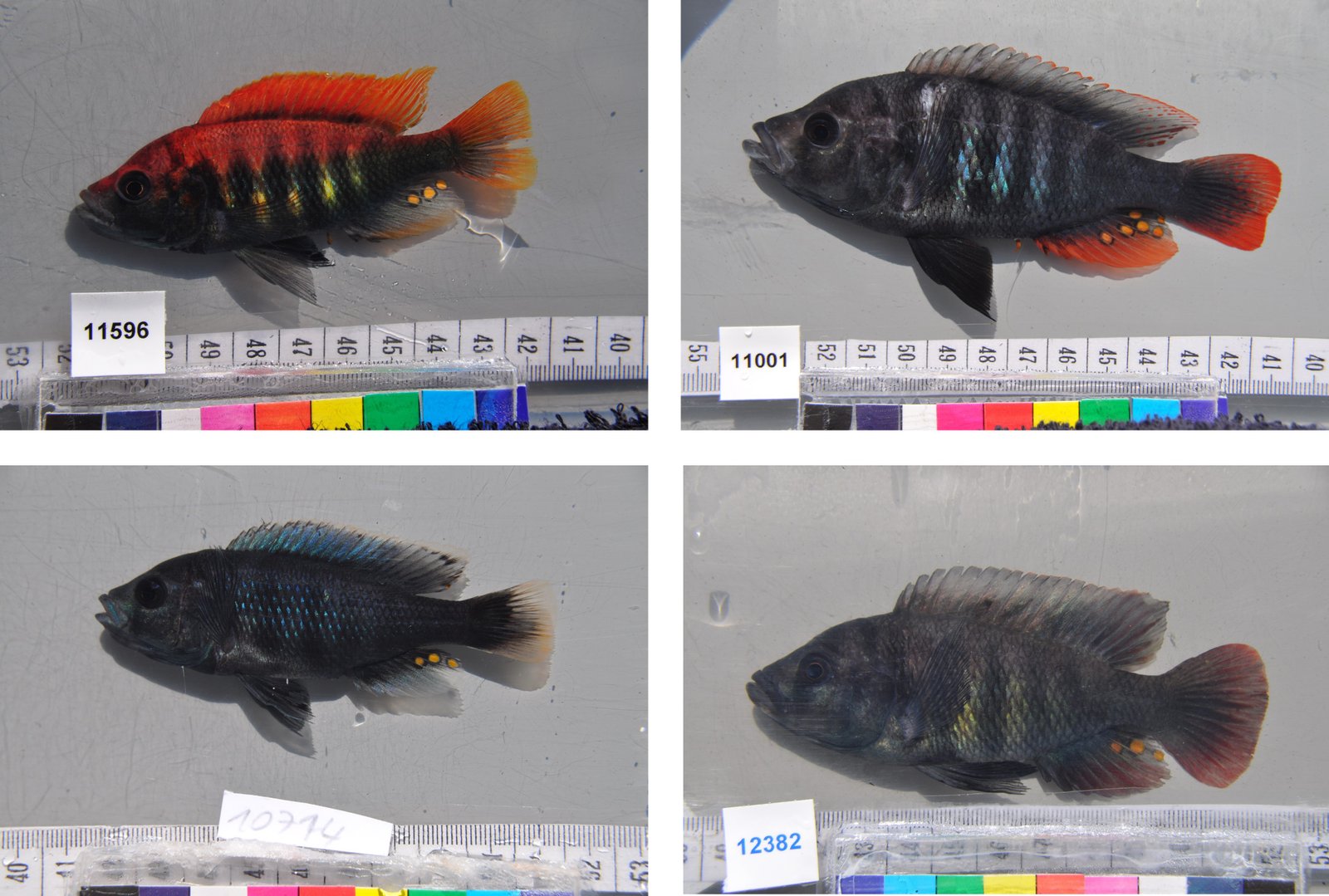
The three brightly coloured fish (Top left, top right and bottom left) are typically coloured males of three sympatric sister species in the genus Pundamilia (nyererei (top left), pundamilia (top right), azurea (bottom left)) that are all found together at clear water islands. The dull-coloured male (bottom right) is a typical male of the single Pundamilia species that is found at turbid water islands (© Oliver Selz & Ole Seehausen)
HS: This paper has three authors. Could you share with us how this group came together for this study and what each person contributed? Also, did the three authors meet in person to discuss ideas etc.?
OS: Sure. Frans Witte and Jacques van Alphen were my thesis advisors at the University of Leiden. I had worked with both of them for several years prior to this. I had first worked on trophic ecology of cichlids at rocky reefs for my Master degree. I really wanted to study the origin of species and we realized that closely related populations that were still in the speciation process were quite similar in their trophic ecology but often dramatically different in male breeding coloration. Jacques van Alphen encouraged me to study mate choice and sexual selection for my PhD project. Jacques contributed mainly conceptual insight and Frans system knowledge during my work that led to our paper. We met at regular intervals. When I was in Tanzania for many months, we would set up telephone appointments every few weeks. There was no working internet in that part of Tanzania in those days and no mobile phone nets! To talk to Jacques or Frans on the phone I had to make an appointment ahead of time, and had to come to town to the house of someone who had a working telephone landline.
HS: Could you give us a sense of what was a typical day like during the time when you did the transect to sample the 13 rocky islands? Where did you stay? How did you travel between sites? Who helped you with the sampling? etc.
OS: These were very long and incredibly exciting days. It was more than 13 islands. The 13 were just the N-S transect, but I also measured an E-W transect and worked on many other islands away from both transects. Many of the rocky reefs and islands were very far away from my host institution, the Tanzania Fisheries Research Institute (TAFIRI) in Nyegezi. I had a 7m long fiberglass canoe with a 25HP outboard engine. Travel time to the islands ranged from under an hour to more than 4 hours (some were even further away and required overnight trips, but these were not part of the transects). We had to leave very early in the morning, usually between 4 and 6am, to have sufficient time for the fieldwork at the islands. You have to have the nets all set before 9am and take them in again before 12am. Around noon, the lake becomes very rough, such that it is impossible to drive a canoe around the rocks and take in nets. I stayed in a rental house in a village a few kilometres away from the institute. I rented a little car from a friend, a teacher at the nearby fisheries school (who later became the Director of Fisheries in Tanzania). I would get up around 4am (earlier for the very distant islands), drive a couple kilometres to pick up my field assistance from their home, then to the institute at the lake. We would load the boat with all the field equipment in pitch-dark night. Electricity got cut in the evening after 8pm and would not return until well into the morning. We filled our boat with boxes, with fishing nets, a large cooler box to keep fish, buckets, diving equipment, photographic equipment, spectrophotometer etc.
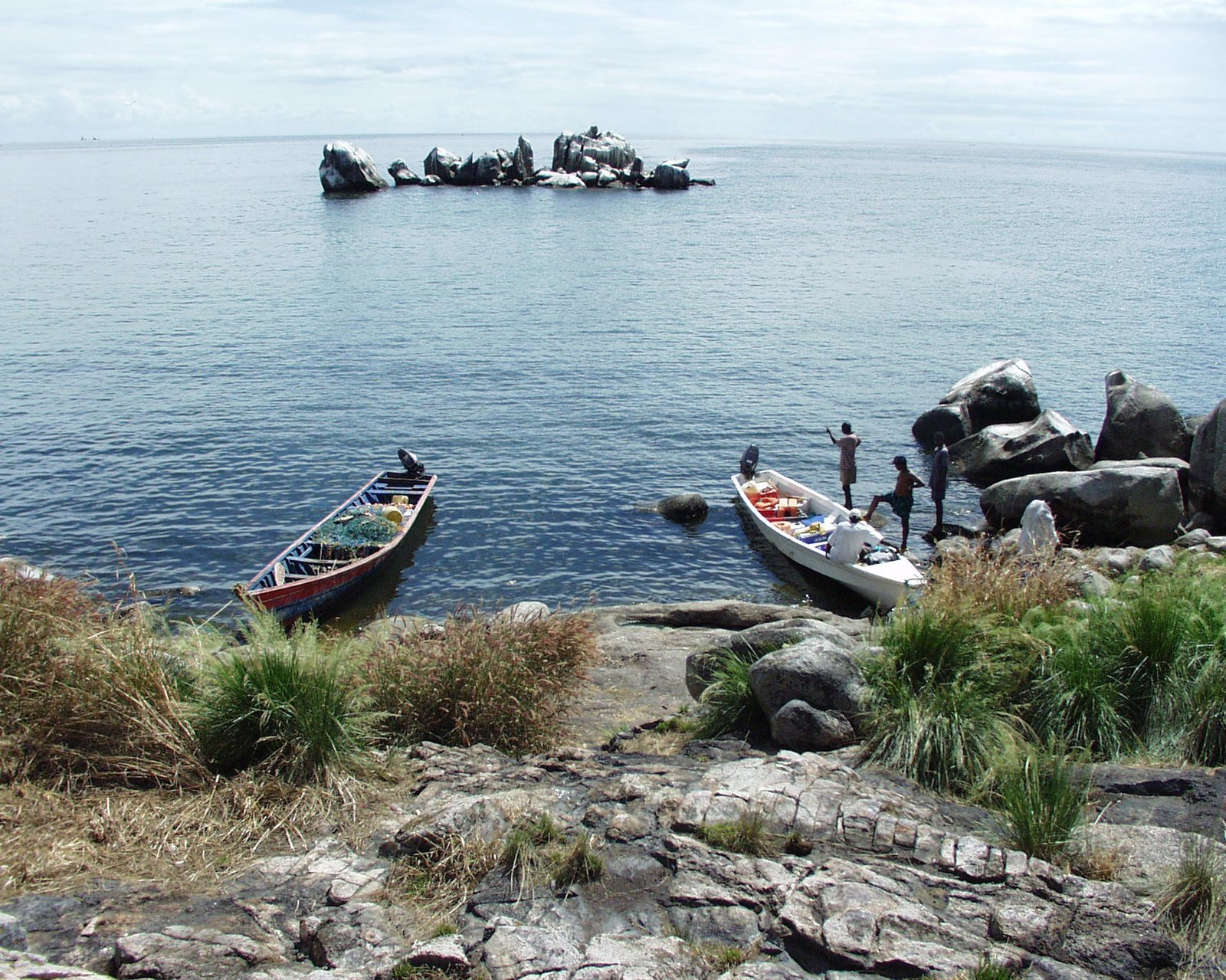
Ole Seehausen’s field team on their research vessel (white) working alongside fishermen on a remote island in Lake Victoria (© Ole Seehausen)
The mornings on the lake were beautiful; usually the lake is very calm at that time of the day and the sunrise is spectacular. The lake is huge, larger than Switzerland, so it is like being on the ocean. We aimed at arriving at islands at 8am and the first job was to take spectrophotometric light measurements. It was important to take these measurements at the same time at all islands. I also wanted clear skies, to have similar sunlight conditions at each island. I had built a large wooden box with polysterol filling and a bright red plastic foil around it to hold my laptop and the spectrometer. I had a 10m long optical fibre cable. This was usually lying on the floor of the boat. It had a heavy industrial coating, but I still managed to break it once! Measuring took some 30 minutes if everything went well, but the software was quite unstable and I often had to reboot and repeat (actually the software to make the spectrophotometer communicate with the laptop was so difficult that I was about to fail getting it to work at all, was it not for the help of my friend Laurent Assembe, a grad student in electro engineering, who managed to get it all working the night before I flew to Tanzania).
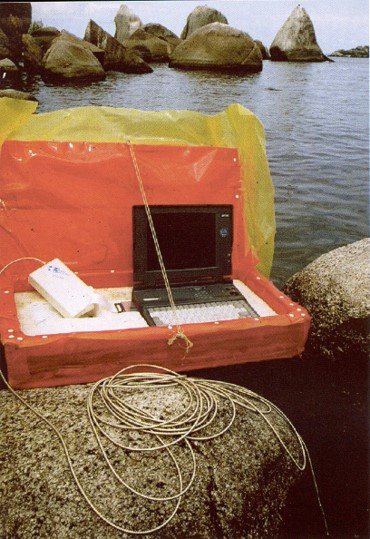
The spectrometer in action in its protective box on the rocky shores of Lake Victoria in 1996. The plastic foil around the box used to be bright red, before it got bleached by the sun. Note the 10m long optic fibre cable. (© Ole Seehausen)
After measuring the aquatic light spectra, we would set nets. I would record the water depth every few meters and make drawings in my field books showing net position. Then my field assistants would go fishing for inshore and crevice-dwelling cichlid species with hook and line and I would go scuba diving to do visual surveys and transect counts. Just before noon we would pull the nets. Often times I would inspect the nets while Scuba diving, and remove the most precious fish already under water and take them up in plastic bags to have them show their best colours. In turbid water areas, this was impossible because there were crocodiles and you would not see much under water at all. On a typical day we would identify several hundred cichlids, record depth at capture for each, and take live colour photos of many. It is important to know that the rare species in these rich assemblages come as singletons among many hundred that you inspect. So you really cannot afford to lose a single fish in the documentation process if you want to measure species richness. This is something I have often seen people overlook, but it stuck with me through the rest of my career and influenced my work on fish assemblages elsewhere too.
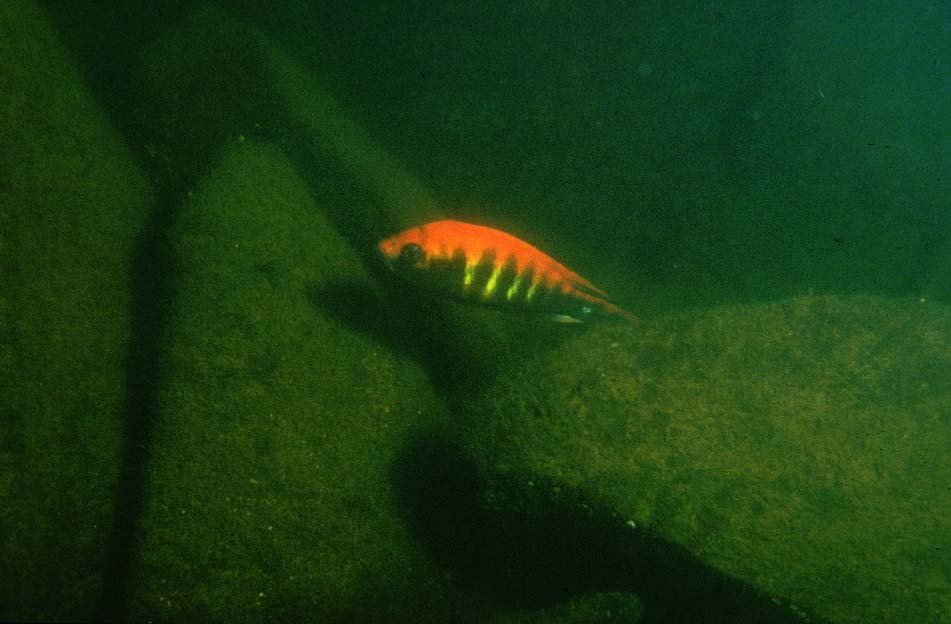
Pundamilia nyererei male in its territory, taken in 1996 at Makobe Island in 8m water depth (© Ole Seehausen)
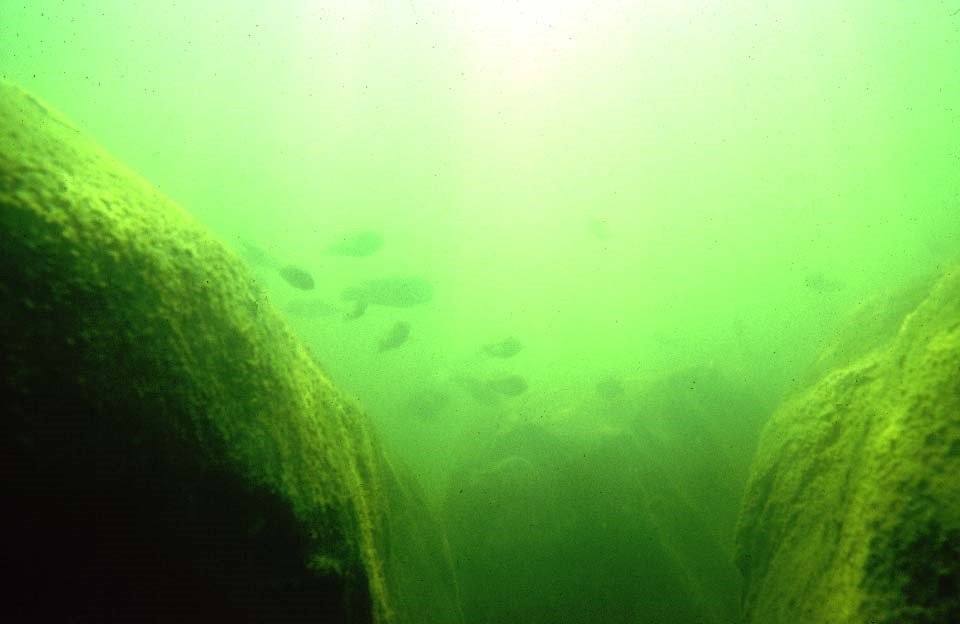
A group of foraging Neochromis under water near Makobe Island, taken in 1996 (© Ole Seehausen)
We would return to the station in the late afternoon. I would drive my assistants to their homes and then start opening the big ice box which contained the catch, all sorted into small bags by net and capture depths. Processing the fish included confirming identification-relevant traits under a microscope, taking some morphological distances, taking tissue samples for genetic work, and preserving the fish in formalin. I don’t think I ever finished before 10 or 11pm, with the last 3 hours under oil lamp or candle light. Anna, my wife to come, assisted me every night. She also often did stomach content analyses of some of the fish (those whose feeding habits I did not know yet) the next day while I went back to the lake again. None of this would have been possible had I not had the support from three tireless field assistants, Mhoja Kayeba, Mohamed Haluna and Ruben Enoka, and my wife Anna. The hospitality of my host institution, TAFIRI, and the friendship with many Tanzanian colleagues were also essential
We also collected fish alive and kept them in the aquaria at TAFIRI for later shipment to the Netherlands. We successfully started breeding colonies in Leiden of at least 10 different species and populations. I later conducted common garden and behavioural mate choice experiments under different light conditions with these fish to ask if male breeding colour differences between species were heritable, and if they mattered for mate choice and reproductive isolation.
HS: You thank “M. Brittijn for the figures”. Could you tell us who M. Brittjin was and how were these figures drawn?
OS: Martin Brittijn was a scientific illustrator at the Leiden Institute for Ecological and Evolutionary Sciences. He was a very busy and very central person in the institute. He made or improved the figures for everyone! I usually made my data figures in Lotus in those days and would give them to him. He was the only one who had software to insert images into figures and edit the figures to look professional. This was always a real process. We had to line up to get appointments with Martin and sessions were intensive. We had to be well-prepared to leave the meeting with figures good for print.
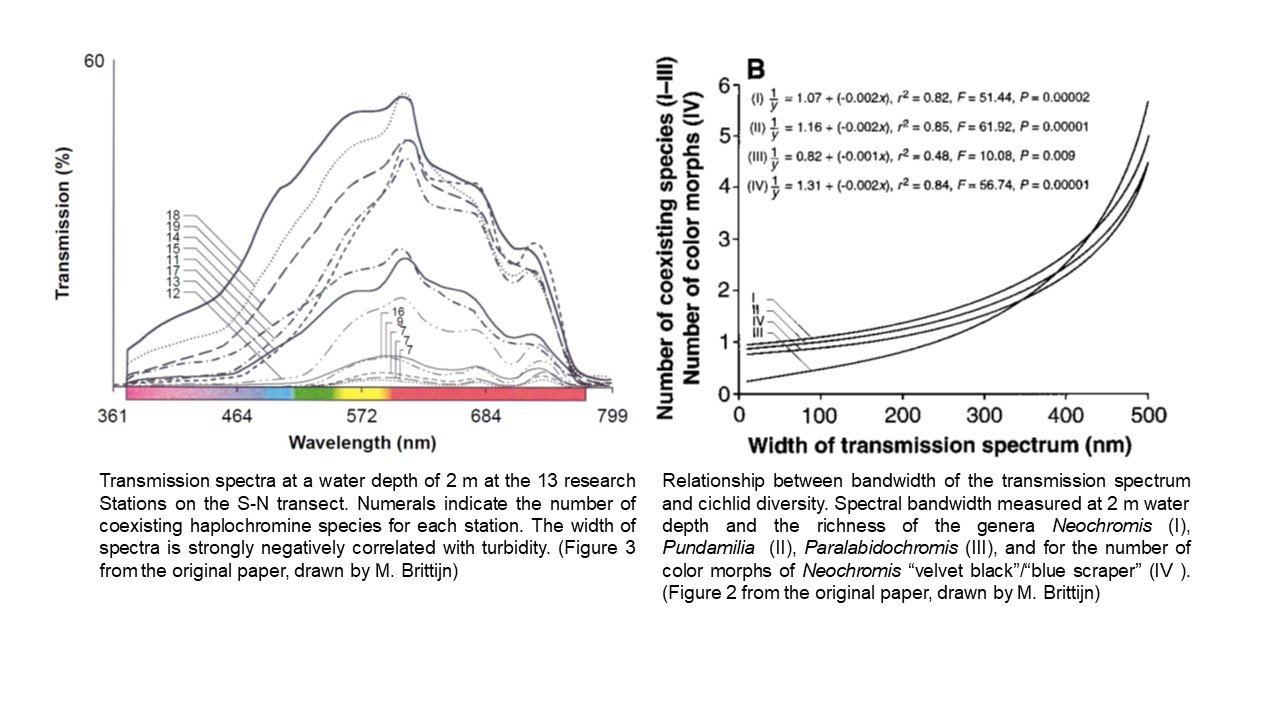
HS: You “particularly acknowledge J. Yoshimura for stimulating discussions”. Could you share with us who J. Yoshimura was and how he/she got involved in this work?
OS: Jin Yoshimura is a theoretical ecologist who visited the Leiden lab at the time I was working on the manuscript. I believe he was working in England in those days. He studied Fisher’s Sexy Son Hypothesis using computer models. He was excited about my data and we discussed speciation by sexual selection. He contributed a paragraph on how the sexy son mechanism might explain the diversification of Lake Victoria cichlids for an earlier version of the manuscript that we submitted to Nature. When we extended the paper for the submission to Science we came to the conclusion that other mechanisms of sexual selection could equally well explain our data (including good genes and sensory drive) and we broadened the concepts. Jin later published a full version of his model together with Masakado Kawata (Kawata & Yoshimura 2000. Speciation by sexual selection in hybridizing populations without viability selection; Evolutionary Ecology Research, 2: 897–909).
HS: How long did the writing of this paper take and where did you do most of the writing? During the writing, how were drafts shared among the three authors and commented upon?
OS: I wrote a first draft of the paper in Tanzania in 1996. I remember I took a day or two off from fieldwork and wrote it. This was quick and the concept was there. I added more data and analyses, and especially experimental data, after I was back in Leiden and had shown, in behavioural mate choice experiments, that female mating preferences between the species were lost when male colour differences were masked by experimental light conditions. Upon my return from the field in 1996, I first wrote my book about the cichlid fish of the rocky shores of Lake Victoria, which was published later the same year. Right after that, I started working full-time on the paper. Sadly, one of my two advisors, Frans Witte, was hospitalized during some of this time but he could sometimes comment on drafts. I saw Jacques van Alphen nearly every day and we would discuss the paper regularly. Drafts were shared as printed paper copies and Frans and Jacques would scribble their comments into the paper margins. I moved back and forth between writing and analysis for about a year.
HS: Did this paper have a relatively smooth-ride through peer-review? Was Science the first place this was submitted to? In what ways did the final published version differ from the first submitted draft?
OS: Yes and no. This manuscript was submitted directly to Science. However, we had sent an earlier and much less fleshed out manuscript to Nature. It was not sent out for review. At Science we got three constructive and positive reviews. They made some excellent suggestions and wanted to see a few additional analyses. The revised version was seen again by reviewers and they recommended acceptance.
HS: What kind of attention did this paper receive when it was published? Were the results considered controversial? Did you anticipate at all that this paper would have such a big impact over the years? What does this paper mostly get cited for?
OS: No, I could not anticipate that the paper would have such an impact. It received a lot of attention. I was called by several large newspapers, including the New York Times, Le Monde and the biggest Dutch Newspapers, on the day of the release and these and several other large newspapers carried large articles. I was completely unprepared for this. I had never experienced anything like that before. I don’t think the paper was considered controversial by the media. Some scientists found it controversial because in those days predation by the invasive Nile perch was seen as the only major cause of cichlid species diversity loss. Some thought we proposed the loss of behavioural reproductive isolation due to increased turbidity as an alternative explanation for cichlid extinction, alternative to predation. But these mechanisms (and also competition with Nile perch) are complementary and interactive. Predation primarily affects cichlid biomass and abundance, whereas loss of species differentiation affects species richness and functional diversity. Some years later Nature carried a nice story about my research in which they gave me room to explain the interaction between these processes. I think the paper gets cited for two things. On the one hand, it was one of the first empirical papers that demonstrated a clear relationship between behavioural mate choice, sexual selection on male nuptial coloration and speciation in cichlid fish. On the other hand, this was the first paper that proposed that the changes to the environmental context in which speciation happened can reverse the speciation process. This phenomenon is now referred to as “speciation reversal” or “reverse speciation”, and has been demonstrated in several other groups of fish, as well as in Darwin’s finches.
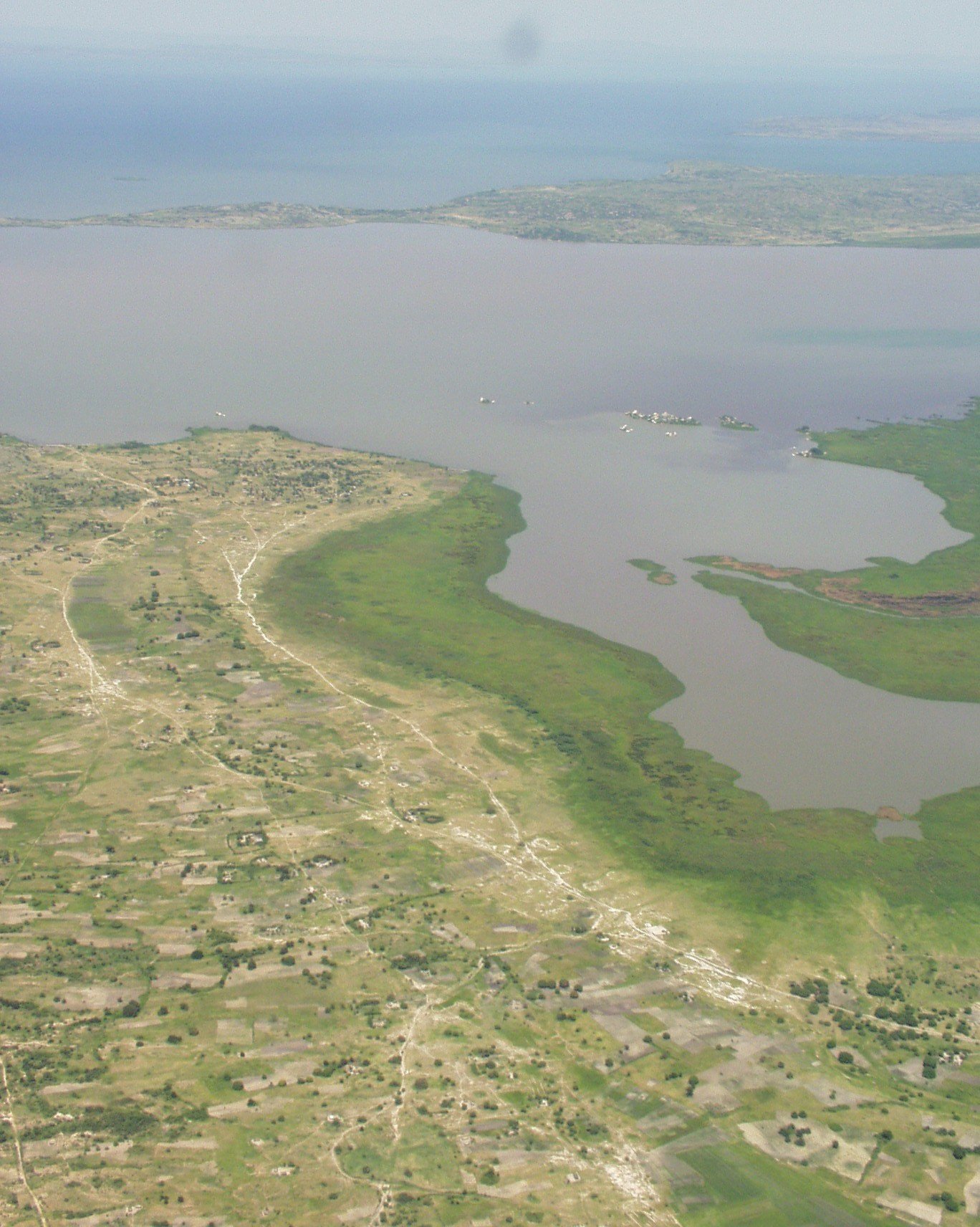
Water turbidity gradient in the Speke Gulf, Lake Victoria, Tanzania. Cichlid species diversity was found to change by a factor of 5 along such gradients during the study (© Ole Seehausen)
HS: What kind of an impact did this paper have on your career and the future course of your research?
OS: In retrospect, it had a very large effect. I had a small scholarship as a graduate student that barely paid my living, and only for two of the four years of my PhD project. Soon after the paper came out Jacques van Alphen and I got a grant from the Dutch Science Foundation and a proper salary that paid enough for me to be able to fully concentrate on the science. The paper did a lot to help establish my career beyond that too. Shortly after my PhD, I received a Marie Curie fellowship from the European Union to continue working on the theme. The discovery of the importance of environmentally modulated behavioural reproductive isolation between species was very exciting and opened my eyes for the various roles that hybridization between species has in evolution, ecology and conservation biology. In the 1997 paper, we showed how homogenisation of the environment may cause rapid loss of species diversity through an evolutionary process (the reversal of the speciation process if you like). In the years after that, I worked on the question if hybridisation might facilitate the origin of new species diversity when the environment becomes more heterogeneous. I am still working on these things today.
HS: Today, 19 years after it was published, would you say that the main conclusions are still, more-or-less, true?
OS: Yes, I would say so.
HS: If you were to redo this study today, would you do anything differently, given the advances in technology, theory and statistical techniques?
OS: Well, time has moved on and our abilities to do evolutionary ecology are quite different now than they were 20 years ago. I would sequence genomes or partial genomes of population samples of as many species as possible, from several islands along the water clarity transect. I would then use this data to quantify patterns of genetic exchange at islands with different water clarity. In fact, this is something my lab is doing right now, and it has only become realistically possible at the scale of entire species assemblages in the last one or two years. Ideally, I would analyse the data in conjunction with demographic modelling of introgression and divergence at the community level, but even the best available modelling frameworks are stretched to their limits by the complexity and number of parameters required to model gene flow and divergence among many different species simultaneously.
HS: In Note 12 of the paper, you refer to unpublished data from “E. Lippitsch, O. Seehausen and N. Bouton”. Did this data form part of a future paper?
OS: Yes, partly. This referred to the existence of diagnostic scale and squamation characters that show that Pundamilia and Platytaeniodus were only distantly related lineages within the Lake Victoria cichlid radiation. “Distantly related” is relative of course because the entire radiation is young, but the point was that these are not sister species. The data we referred to became part of a systematic revision of the Lake Victoria rocky shore cichlids that we published one year later (Seehausen, Lippitsch, Bouton, Zwennes 1998. Ichthyological Exploration of Freshwaters 9, 129-228).
HS: In Note 12, you present experimental evidence (from your own and other studies) for the lack of post-reproductive mating barriers. Subsequent to this paper, have there been any reports of hybridization in the wild?
OS: Yes. Several later papers found substantial evidence for hybridization among species of Lake Victoria cichlids, especially in turbid water sections of the lake. As an interesting corollary, while in the 1997 paper we showed how hybridization can collapse species diversity when the environment becomes more homogeneous (such as in turbid waters), hybridization may also facilitate diversification when a hybrid population colonizes a heterogeneous environment. We now have a paper in press demonstrating that all the species radiations of cichlid fish in Lake Victoria and other lakes in the region emerged from an ancient hybrid population between two very distantly related species. However, while loss of reproductive isolation in homogenized environments can collapse large species diversity within a few generations, the origin of many new species from a hybrid population that returns to a heterogeneous environment will take many hundreds to several thousands of generations. Hybridisation-mediated loss and gain of species diversity appear to operate at different time scales.
HS: This paper has a really lovely sentence: “Where eutrophication turns the lights off, ecological and species diversity erode rapidly”. Do you remember who came up with that sentence?
OS: That was me.
HS: What has happened to these sites and the cichlid fishes in the 19 years since this study? Do you continue to work in these sites? When was the last time you visited this area?
OS: My students and I have kept working on these sites ever since. The relationship between water transparency and species diversity is very similar now to what it was in 1995 and 1996 when the data for our paper was collected. Several species appear to have been lost since then particularly at the more turbid sites, but I have also documented population expansions into the clear water areas of several species that back then occurred only in the turbid areas, and some of these may be of hybrid origins. We are working on the genomics of some of these species.
HS: In the last lines of this paper you write “Pollution also threatens the other African Great Lakes and if not counteracted by management policies, will destroy large parts of the unique example of vertebrate evolution that the lacustrine cichlids represent”. Could you reflect on these lines in the context of what’s happened since the time you wrote them?
OS: Eutrophication has become an issue in several other African Great Lakes too, including the deep rift lakes Malawi and Tanganyika. There have been several reports about increasingly frequent loss of clear water conditions in parts of Lake Malawi. At least one paper suggested a relationship between increased water turbidity and hybridisation in Malawi cichlids. There are also strong suggestions that the biodiversity of Lake Tanganyika is negatively affected by increased siltation. Moreover, eutrophication has had very negative effects on endemic diversity of salmoniform fishes in European deep lakes. In a paper published in 2012 we showed that the mechanism involves the loss of reproductive isolation between sympatric closely related species mediated by the loss of habitat heterogeneity. Climate change is the other very serious threat to endemic biodiversity in the great lakes of Africa and elsewhere.
HS: In the 19 years since the paper was published have you ever read it again?
OS: Maybe two or three times in the earlier years.
HS: Among all the papers you have published, would this count as a favourite? If yes, why?
OS: That is a difficult question. I still like it a lot.
HS: What would you say to a student who is about to read this paper today? What should he or she takeaway from this paper published 19 years ago?
OS: Perhaps that thinking in terms of evolutionary processes is crucial if we want to understand effects of environmental change on biological diversity, no matter what time scale. Perhaps also that studying contemporary environmental change and the associated changes in species and species diversity can provide strong leads to uncovering principles of evolutionary biology.

0 Comments
Trackbacks/Pingbacks